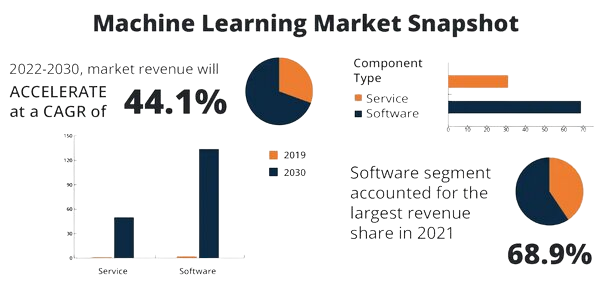Project Report For Machine learning
Introduction
Machine Learning project report is as follows.
Machine learning is a subfield of AI, defined as ability of a machine to imitate intelligent human behaviour. Learning and improving upon past experiences. It works by exploring data and identifying patterns and involves minimal human intervention.
The process by which computers learn to recognise patterns, or the capacity to constantly learn from and make predictions based on data, then make modifications without being expressly programmed to do so, is known as machine learning (ML), a subcategory of artificial intelligence.
Machine learning is significant because it aids in the creation of new goods and provides businesses with a picture of trends in consumer behaviour and operational business patterns. A significant portion of the operations of many of today’s top businesses, like Facebook, Google, and Uber, revolve around machine learning.

Machine Learning is the branch of science that studies how computers can learn without being explicitly programmed. ML is one of the most intriguing technologies that I have ever encountered. As the name implies, it offers the computer the ability to learn, which makes it more human-like. Machine learning is being employed actively now, maybe in more places than one would imagine.
Project Report Sample On
Machine Learning
Get Completely Custom Project Report
The way in which a prediction-making algorithm learns to improve its accuracy is a common way to classify traditional machine learning. There are four fundamental strategies: reinforcement learning, semi-supervised learning, unsupervised learning, and supervised learning.
The kind of data that data scientists wish to forecast determines the kind of algorithm they use. There are four types of machine learning – Supervised Machine Learning, Unsupervised Machine Learning, Semi-Supervised Machine Learning, and Reinforcement Learning.
Market Potential Of Machine Learning
The market for machine learning (ML) was valued at USD 6.91 billion in 2021 and is projected to grow at a 44.1% CAGR in terms of revenue over the next five years. Technology advances and the rising trend of cloud computing are anticipated to fuel the machine learning market’s revenue expansion. Systems can learn, anticipate, and improve their algorithms thanks to machine learning.
As new risks are identified, antivirus software, for instance, learns to screen them. Even in contexts that are dynamic or unpredictable, the algorithms can manage data that is multidimensional and multivariate. Additionally, it is expected that the usage of Generative Adversarial Networks (GAN) and the Internet of Things (IoT) would grow, contributing to a higher revenue CAGR between 2022 and 2030.

Applications of machine learning in the real world have improved the usability, speed, efficiency, and accuracy of routine processes. Machine learning systems are educated precisely to accomplish jobs more quickly and correctly than people thanks to data science. This technology is being used by a number of business leaders across the globe to acquire a competitive edge and link company objectives with employee interests.
With the use of data analytics, computers can continuously learn from data, make predictions based on that data, and make changes without being explicitly programmed to do so. This process is known as machine learning, a subtype of artificial intelligence.
Processing and extracting insights from the enormous data volume produced when people and other environmental elements interact with technology would be tremendously challenging without the speed and sophistication of machine learning and deep learning. Additionally, ML has enormous promise for developing technologies like self-driving cars and “smart cities” with infrastructure that can automatically save time and energy waste, as well as wearable data-driven devices that track fitness and health goals.

